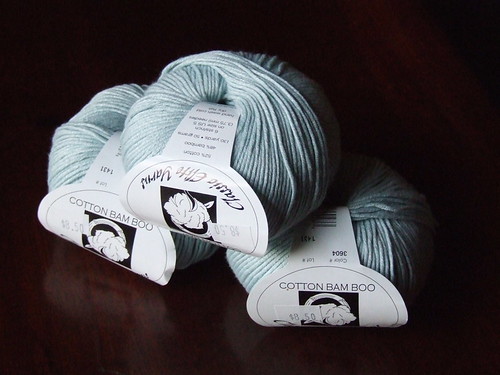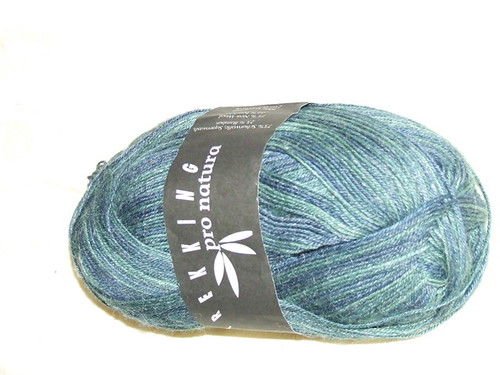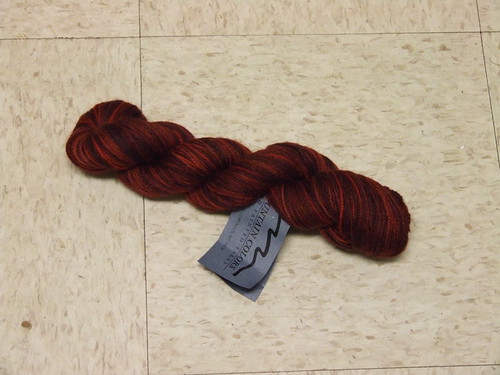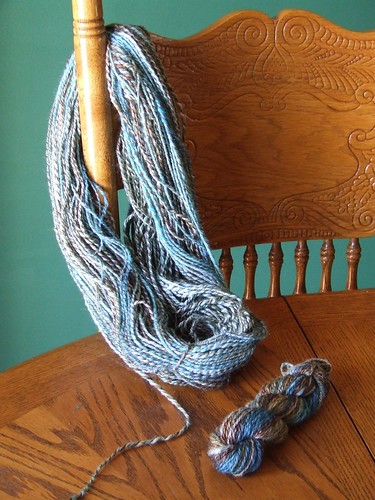Of course, I felt like I needed to do some research. Here are my conclusions.
The meaning of the word "ball" is fairly straightforward. A ball is yarn wound up, ready to be knit.
The most obvious shape looks like this:

Some people seem to be unaware, but these spherical balls of yarn can be center pull balls. There are many tutorials about how to make center pull balls of yarn, but it comes down to making sure that you don't lose the end of the yarn in the middle of the ball you are winding. The most traditional way to make a center pull ball is to use a nostepinne, though using two fingers may be an older technique.
There are some sub-categories of ball that aren't entirely spherical:
A "cake" is what you end up with after using most ball winders. It is round, but flat on the top and bottom. In some circles, when you wind a ball on a ball winder, you "muffin up" your cake of yarn. In fact, most ball winders are essentially mechanical nostepinne, and what you end up with from a nostepinne is usually a cake. It looks like this:

According to some, balls like the following are called "mushroom puffs", though I had never heard the term before:

These may collapse, but I think that's more the result of the fiber content than the shape. When knitting with wool or another feltable animal fiber, you can pull from the center of the ball, but with plant fibers and silk, you should pull from the outside, because otherwise the ball will collapse because nothing is holding it up.
Some people have no problem calling this ovoid shape a "ball":

But, then they rebel when faced with something more log-shaped like this:

"It can't possibly be a ball," they think, "It's not remotely spherical. It must be a skein."
Now, if I was in a yarn shop, I would not batt an eye if you called this a skein. However, if you then told me that the following was not a skein, I would be totally confused:

You see, I do sometimes use the word "skein" to refer to a generic unit of yarn. However, if you asked me the shape of a skein, I would say that a skein starts out looking like this:

Then, it gets twisted up for storage, and it looks like this:

I would say that the log-shaped thing above is a ball, because it is wound up, ready for knitting. Some people would say that since a skein is something else, that those twisted loops above are "hanks", not "skeins."
That really struck me as wrong, and it's what made me look things up. I had no problem with these being called hanks (though I tend to think of hanks as larger), but in my experience, they were definitely also called skeins. All of the instructions I have read for different types of hand-dying refer to these loops as skeins. As a spinner, saying that these are not skeins particularly bothered me. That is because there are several pieces of equipement that spinners use for making skeins. One is a niddy noddy:

(This one's an Ashford from Dharma Trading)
The other is a skein winder (or the similar clock reel or weasel, which measures the yarn as well):

(This one's from Louet)
Clearly, when you use a skein winder, you end up with a loop of yarn, not a thing of any shape that is ready for knitting, unless you're being lazy and want to end up with a huge tangle of yarn.
I also looked at the definitions in the Oxford English Dictionary.
Hank:
Pronunciation:/haŋk/
noun
1 a coil or skein of wool, hair, or other material:
a thick hank of her blonde hair
2 a measurement of the length per unit mass of cloth or yarn, which varies according to the type being measured. For example it is equal to 840 yards for cotton yarn and 560 yards for worsted.
3 Sailing a ring for securing a staysail to the stay.
Origin:
Middle English: from Old Norse hǫnk; compare with Swedish hank 'string' and Danish hank 'handle'
Skein:
Pronunciation:/skeɪn/
noun
1 a length of thread or yarn, loosely coiled and knotted.
an element that forms part of a complex or complicated whole:
he weaves together the skeins of philosophy, ecology, folklore, and history
2 a flock of wild geese or swans in flight , typically in a V-shaped formation.
Origin:
Middle English: shortening of Old French escaigne, of unknown origin
Clearly, the difference between a hank and a skein is that a hank may apply to any material, and when it does apply to yarn, it is a specific measurement. Also, the origin is different, so different people brought different terms into the language to mean essentially the same thing.
Why, then do some people use the word "skein" to specifically refer to these log-shaped balls? Why is this such an accepted use that it appears in books that are supposed to be teaching beginners the correct terms? Apparently, the major craft store retailers started calling those log-shaped balls "skeins", and confusion has reigned ever since.
Personally, I think it's fine that the word "skein" is often used to mean "unit of packaged yarn". These units aren't a specific weight or yardage, as in "I will need seven skeins of Alpacana Tweed to complete a pullover, but only two skeins of Alpaca with a Twist, because the Alpaca with a Twist comes in a skein with more yardage." This sentence makes complete sense, even though the Alpaca with a Twist comes as loops of yarn, and the Alpacana Tweed comes in ovoid center-pull balls. The sentence "I will need to wind the skeins of Alpaca with a Twist into balls before I can begin knitting with them," also makes sense with the more narrow definition of skein, as seen in the OED. These are the ways that I would recommend using the word "skein", though it is fine to avoid the former. I do think that generic use is why those log-shaped balls started to be called skeins.
Also, as long as we're talking about the narrow definition of the word "skein", there are two reasons that yarn is sold in skeins rather than in balls, ready for knitting.
1. Hand-dyed yarn is usually dyed in skeins in order to achieve the desired effect. Selling the yarn as a skein reduces the dyer's work on each skein, and therefor keeps the price lower.
2. Storing yarn under tension, as in a ball, for long periods can affect the twist. So, don't wind your skeins into balls until you're ready to work with them.
No comments:
Post a Comment